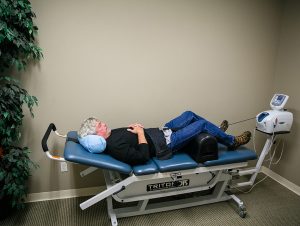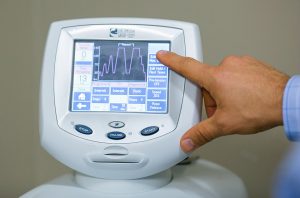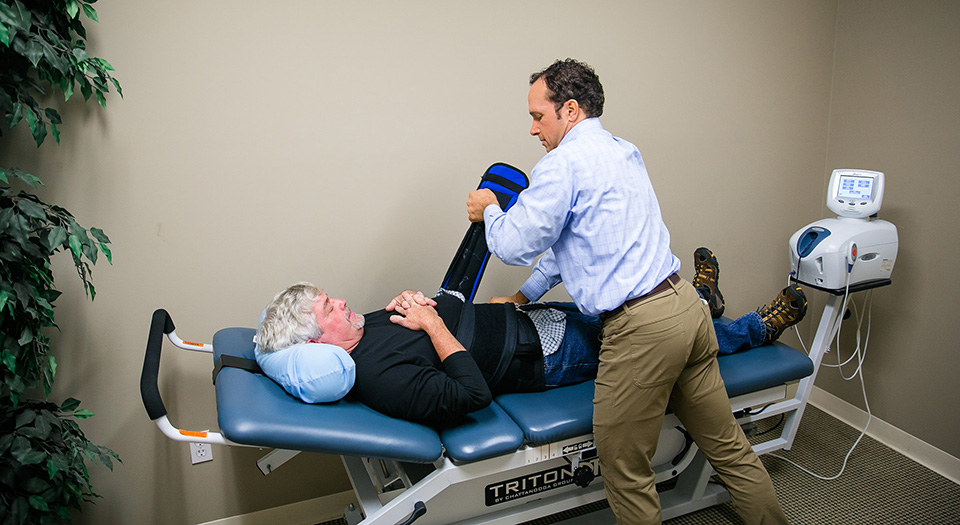Dr. John Hood is excited to offer Non-Surgical Spinal Decompression Treatment.
This treatment is highly successful for patients complaining of disk herniation and sciatic-like pain in the legs. Please read the information below about Decompression Treatment and check out the testimonial link.
Non-Surgical Spinal Decompression
Non-surgical spinal decompression therapy is a highly successful, non-surgical alternative procedure for relieving low back, neck, and arm and leg pain. It is an effective treatment for:
- Herniated or bulging discs
- Sciatica
- Degenerative disc disease
- Post-surgical patients
- Facet syndrome
- Spinal Stenosis
What is Decompression Theraphy?
Decompression Therapy is a non-surgical procedure that effectively treats disabling low back, neck, and radiating leg and arm pain. Decompression Therapy effectively relieves pain associated with disc herniation, degenerative discs, and posterior facet syndromes, due to decompression of spinal discs and facet joints which is unloading due to distraction and positioning.
Decompression Therapy effectively enhances the healing process and renders quick, effective and amazing pain relief that enables most patients to return to a more active lifestyle.
Research to develop this procedure was conducted by prominent physicians, engineers and technicians at major teaching hospitals.
Do you have a herniated disc, multiple herniated discs, degenerative disc disease, facet syndrome? Is your doctor suggesting surgery, pain management, or physical therapy? Call Dr. John Hood at the Chiropractic Care Center in Sevierville, TN for a free consultation about our non-surgical spinal decompression program.
Spinal decompression is FDA approved and has been clinically proven with an 86% success rate with the pain and symptoms associated with herniated and/or bulging discs…even after failed surgery.
Research indicates that the disc is responsible for a significant number of lumbar/leg pain and neck/arm pain syndromes. Compression increases internal disc pressure leading to possible protrusion, herniation and bulging of disc material.
Spinal decompression therapy in conjunction with the additional treatment modalities provided in our clinic can, in most cases, effectively relieve the pain and disability resulting from disc injury and degeneration, by repairing damaged discs and reversing dystrophic changes in nerves. Spinal decompression treats the functional and mechanical aspects of disc caused pain through non-surgical decompression of spinal discs.
Studies verify the significant reduction of internal disc pressures which result in the non-surgical decompression of the disc and nerve root. Conventional traction has never demonstrated a reduction of this internal disc pressure; on the contrary – many older traction devices actually increased internal disc pressure, most likely due to reflex muscle spasm.
Our computer controlled spinal decompression equipment is designed to apply distraction and decompression to the patient’s spine without producing reflex paravertebral muscle contractions.
By significantly reducing internal disc pressure, spinal decompression promotes retraction of the herniation back into the disc and promotes intake of fluids, oxygen and other substances necessary for healing the disc. This activity stimulates repair and inhibits leakage of materials from the nucleus of the disc.
The most recent research trial sought to correlate clinical success with MRI evidence of disc repair as a result of treatment and found that reduction of disc herniation ranged between 10% and 90% depending on the number of sessions performed, while disc annulus healing was evident in all cases.
The most recent clinical study of 219 patients has shown that spinal decompression therapy provided nearly immediate resolution of symptoms for 86% of the participants, and 84% remained pain-free 90 days after the treatment was finished. See our section on spinal decompression clinical studies.
What Are The Treatments Like?
After lying on the comfortable spinal decompression bed, you will be fitted with a support system. The support system helps to stabilize your body. The advanced computer system automatically adjusts to the proper angle of distraction, an air bladder system acts as a fulcrum for the angle of pull, allowing us to target the specific discs that are causing your pain and symptoms. The distractive forces utilize a computer controlled logarithmic curve to avoid reflex responses which would create muscle spasm. The split table design decreases friction and allows separation of the vertebra.
 Basically, you lay down on the table and the spinal decompression computer simulates an anti-gravity effect on your spine that helps herniated material return toward its normal position thus reducing pressure and pain. Patients describe the treatment as a gentle, painless, intermittent pulling sensation. Many patients actually fall asleep during treatment!
Basically, you lay down on the table and the spinal decompression computer simulates an anti-gravity effect on your spine that helps herniated material return toward its normal position thus reducing pressure and pain. Patients describe the treatment as a gentle, painless, intermittent pulling sensation. Many patients actually fall asleep during treatment!
How Long Are Treatments And How Many Do You Need?
Patients typically undergo 15 to 20 treatment sessions. Each treatment lasts between 45 and 60 minutes. This, of course, depends on your individual case and is determined by thorough pre-treatment evaluation. Following each session, a cold pack and electric muscle stimulation is usually applied to speed the healing process. It is important to note that many patients get substantial, immediate relief after just a few treatments. Some have significant reduction of pain after just one session. The really good news is that this is not something you have to continue to do for the rest of your life! So it is not a big commitment.
Can Spinal Decompression Therapy Help My Pain?
Though each patient is different and no doctor can guarantee success, the clinical results of this type of therapy have been shown to be effective in 86% of patients treated. The common problems of many back conditions are damaged discs and poor spinal muscle control. Our treatment program addresses both of these core problems. The specially designed spinal decompression equipment creates a controlled unloading of the spine to decrease disc pressure thus increasing blood and nutrient exchange. This exchange of fluids is something the damaged disc desperately needs to help it heal from the inside out. Muscle strength, control and endurance can all be improved with our spinal decompression therapy program that includes specific controlled spinal exercises.
Will Spinal Decompression Treatments Hurt? Is it Safe?
Spinal Decompression Therapy treatments are one of the most gentle and comfortable therapies available. The treatments utilize FDA cleared equipment with proven safety and efficacy. Most patients report a mild sense of stretch on their back or hips, and often fall asleep during treatment sessions. The spinal decompression system is produced by one of the world’s largest manufacturers of hospital based therapy and rehabilitation equipment.
Is Spinal Decompression Therapy New?
Although traction therapy has been around for thousands of years, Spinal Decompression Therapy is relatively new. Advances in equipment and procedures have dramatically improved effectiveness. Spinal Decompression Therapy is the most comprehensive program available, allowing the safe delivery of this previously hospital based therapy in our office. Continual improvements in the delivery system and regular updates in protocol keep spinal decompression in the forefront of non-invasive disc therapy. Each year over 50,000 patients are treated with spinal decompression therapy and that number is growing. For a complete comparison of spinal decompression with traction and other surgical options, check out the article below “How does spinal decompression stack up?”
How Long Will My Treatment Program Be?
This depends on the complexity and extent of the treatment and rehabilitation needed, however we typically treat 4 times a week for 1 month, transitioning from passive to active treatments as you respond. The treatment is administered over a reasonable timeframe and your response is continually evaluated. Further treatments may be necessary or a reduced frequency may be recommended at that time.
The rehabilitative phase may include additional spinal decompression treatments coupled with exercises, spinal manipulation and adjustments to enhance the results. Most patents are released from treatments after 6 to 12 weeks.
Why is Spinal Decompression Therapy More Successful Than Other Treatment Options?
Spinal Decompression therapy as practiced in our clinic is a comprehensive program of the newest decompression techniques and targeted “core” stabilization exercises combined with Biofeedback. In addition, we use other adjunctive treatments that have proven effectiveness in back care. It is this multi-faceted approach that makes our decompression treatment so effective and is what sets our procedure apart.
Additionally, discs have been shown to be a predominate site of pain, so treating the disc as directly as possible makes sense. The blending of focused traction of the site, rehabilitation to the supporting structures, and overall strengthening of musculature makes the treatment unique. Spinal decompression therapy affects the disc as directly as possible without surgery. For a complete comparison of spinal decompression with traction and other surgical options, check out the article below “How does spinal decompression stack up?”
DTS Decompression vs. Surgery:
Surgery Facts:
- In some cases surgery is necessary, more often it is not necessary.
- Increased danger from anesthetic.
- Increased danger from possible infections.
- Prolonged recovery time after back surgery is generally 6-8 weeks.
- Another 6-8 weeks of rehabilitation and physical therapy at 3 to 5 times per week.
- Lower rate of successful results.
- Without insurance patient’s cost for surgery is often over $25,000.
- Even with insurance, patient’s share of surgical cost is often over $4,000 to $5,000.
DTS Facts:
- Relief of acute or chronic (long term) low back pain and /or associated leg pain or numbness, generally within 4 weeks.
- Successful in over 75% to 85% of patients.
- Early return to work.
- Non-invasive and extremely safe.
- No injections.
- No knifes.
- No drugs.
- No patient hospitalization.
- Cost effective treatment. Usually about $65 per treatment and less than $1,500 total and it is covered by insurance.
Why the Need for Exercises and Other Therapies?
Along with the damage in the disc, we also need to treat the supporting spinal muscles. A complete program targeting the function of the stabilization muscles of the spine is a vital part of spinal decompression therapy. Heat, muscle stimulation, and ultrasonic therapy can offer additional benefits for inflammation and spasm reduction. Our goal is to not only to help heal the disc but enhance muscle control and support of the low back. A gradual breakdown of the foundational support of your back is what puts undue stresses on the discs and leads to disc degeneration, pain and loss of function. Our program of spinal exercise and adjunctive therapies will assist in rehabilitating these structures.
Will My Pain Go Away For Good?
Although it is difficult to predict the future, experience has shown that most patients do find long-term relief or effective management of their pain when they complete the entire recommended program of treatments. Regular home exercise and periodic visits to our clinic will help in maintaining your spinal health and reduce the probability of reoccurrence. As with any comprehensive rehabilitation program, your continued home care exercises and discretion in some daily activities is the key to long-term relief.
How Much Will it Cost?
The cost varies depending on your condition and the extent of care needed. (See above for comparison with cost of surgery.) We promise to only do those procedures necessary for your fullest recovery. You always have the choice as to the extent of care. Our staff will review all costs, payment options and insurance coverage before treatment begins. We want to help and we believe finances shouldn’t stand in the way of your good health.
How Does Triton DTS Differ from Other Spinal Decompression Tables?
Our office uses Trition DTS spinal decompression equipment from The Chattanooga Group, which has become the gold standard for spinal decompression. For a detailed comparison as well as our reasoning for choosing this table, refer to the section below
 How Does Spinal Decompression Stack Up?
How Does Spinal Decompression Stack Up?
With the wide spectrum of back and neck pain treatment options and slight variations of treatment types, it is difficult to determine which will work for you and why. The following sections will answer many of your lingering questions.
How is Spinal Decompression different from traction?
Traction is a simple static force that is put on the patient’s body with the intent of unloading the body’s joints, muscles and other structures. For example, hanging upside-down is a common method to put the spine into traction. Rather than one’s body weight putting stress on the spine, which is what happens when standing erect; the body weight is working to unload the spine.
Various forms of traction have been around for over 1000 years; however, pain relief has been inconsistent and short-lived until now. In fact, several clinical studies have shown ordinary traction to be an ineffective form of back and neck pain relief. The reason is unexpected, but pretty simple. Our bodies react to the static unloading of the spine by contracting, or squeezing, the muscles surrounding the spine. Rather than achieving the desired effect of unloading the spine, the pressure on the spine is actually increased, thus increasing intradiscal pressure. This does NOT allow the discs to re-hydrate and heal, which is what ultimately yields pain relief.
Spinal Decompression, on the other hand, is a modified, updated form of traction. Computer technology is used to control variations in the unloading of the spine, effectively avoiding the body’s muscle contraction response. Notice in the figure below that the traction tension is varied over time according to the graph. The doctor can control how many progressive tension steps are experienced by the patient before reaching the maximum tension. The doctor also has complete control over how long the tensions are held steady and how often they are repeated through the computerized system.


 Dr. John Hood first became interested in chiropractic care when he received a lower back injury while on a 100 mile triathlon training ride in college. His road to recovery revealed a passion for helping restore wellness to others and led to his pursuit of a doctorate in chiropractic.
Dr. John Hood first became interested in chiropractic care when he received a lower back injury while on a 100 mile triathlon training ride in college. His road to recovery revealed a passion for helping restore wellness to others and led to his pursuit of a doctorate in chiropractic.